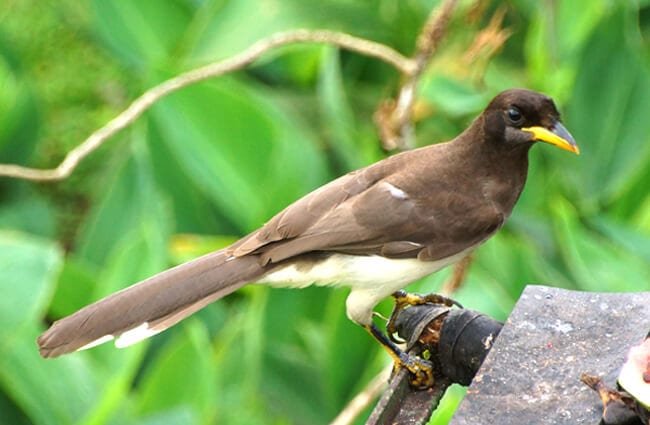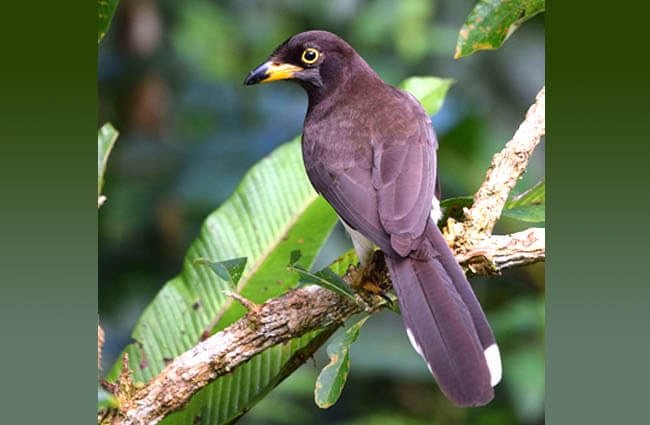The world of avian life is brimming with fascinating creatures, and among the most intriguing is the Brown Jay. Often overlooked in favor of its more brightly colored relatives, this intelligent and social bird holds a unique place in the ecosystems it inhabits. This comprehensive guide delves into the life history, behavior, and ecological role of the Brown Jay, providing insights for students, animal enthusiasts, and anyone curious about the natural world.

Understanding the Brown Jay
The Brown Jay, scientifically known as Psilorhinus brunneus, is a member of the Corvidae family, which also includes crows, ravens, and magpies. These birds are renowned for their intelligence and complex social structures, and the Brown Jay is no exception. Found throughout a wide range of forested habitats in Central and South America, from Mexico to northern Argentina, the Brown Jay is a resilient and adaptable species.
Physical Characteristics
As its name suggests, the Brown Jay is predominantly brown in coloration, with a striking black cap and bib. Adults typically measure between 30 to 35 centimeters in length and possess a relatively long tail. A key identifying feature is the lack of any bright coloration, making it appear understated compared to other jays. Juvenile birds exhibit a duller plumage and lack the distinct black markings of adults.
Habitat and Distribution
Brown Jays thrive in a variety of forest types, including tropical rainforests, deciduous forests, and even secondary growth areas. They are particularly common in the understory of forests, where they forage for food and build their nests. Their range extends across numerous countries, encompassing diverse landscapes and elevations. These adaptable birds can also be found at the edges of forests and in cultivated areas, showcasing their ability to coexist with human‑modified environments.
Behavior and Social Structure
The Brown Jay is a highly social bird, living in cohesive family groups that can range in size from a few individuals to over twenty. These groups typically consist of related birds and cooperate in all aspects of life, including foraging, nesting, and defense. This cooperative behavior is a defining characteristic of the species.
Foraging Habits
Brown Jays are omnivorous, with a varied diet that includes fruits, insects, small vertebrates, and even eggs and nestlings of other birds. They are opportunistic foragers, actively searching for food throughout the forest. Their foraging behavior often involves scanning the canopy and understory, and utilizing their strong beaks to extract insects from tree bark or probe for fruits. The group’s cooperative foraging strategy enhances their ability to locate and exploit food resources.

Cooperative Breeding
A remarkable aspect of Brown Jay behavior is their cooperative breeding system. Typically, only the dominant pair in the group will breed, but all members of the group contribute to raising the young. This includes feeding the chicks, defending the nest from predators, and even helping to build the nest. The helpers, often offspring from previous years, gain valuable experience in raising young, which increases their own chances of reproductive success in the future.
Reproduction and Life Cycle
Brown Jays are generally monogamous, forming long term pair bonds. The breeding season varies depending on geographic location, but typically occurs during the dry season. The nest is a bulky structure constructed from twigs, leaves, and other vegetation, typically placed high in a tree. The female lays a clutch of 3 to 5 eggs, which are incubated for approximately 18 to 20 days.
Raising the Young
Once the chicks hatch, they are entirely dependent on their parents and helpers for food and care. The adults and helpers work tirelessly to feed the rapidly growing chicks, bringing them a variety of insects, fruits, and other food items. The chicks fledge from the nest after about 25 to 30 days, but they continue to rely on their parents and helpers for several weeks after fledging.

Ecological Role and Interactions
Brown Jays play a crucial role in the ecosystems they inhabit. As omnivores, they contribute to seed dispersal and insect control. Their foraging habits can influence the distribution of plant seeds and the populations of insect pests. Furthermore, their cooperative behavior and social complexity contribute to the overall biodiversity of the forest.
Interactions with Other Animals
Brown Jays often interact with other bird species, sometimes competing for food resources. They are also known to mob predators, such as hawks and snakes, alerting other birds to the presence of danger. Their interactions with other animals contribute to the complex web of life in the forest.
Human Interactions
In some areas, Brown Jays are hunted for food or captured for the pet trade. Habitat loss and fragmentation also pose a threat to their populations. Conservation efforts are needed to protect their habitats and ensure their long term survival. They can sometimes become accustomed to human presence in parks and gardens, and may even approach people in search of food.

Advanced Insights for Zoologists and Enthusiasts
Beyond the basics, the Brown Jay offers fascinating avenues for research. Studies have revealed sophisticated vocal communication, with distinct calls used for alarm, coordination, and maintaining social cohesion. Their cognitive abilities, demonstrated through problem‑solving tasks, are comparable to those of other corvids.
Evolutionary History
The evolutionary history of the Brown Jay is rooted in the diversification of the Corvidae family. Phylogenetic studies suggest that it shares a common ancestor with other jays and crows, and that it has undergone significant adaptation to its forest habitat. Understanding its evolutionary history can provide insights into the origins of its unique behavioral traits.
Conservation Status
While not currently considered globally threatened, the Brown Jay’s populations are declining in some areas due to habitat loss and fragmentation. Monitoring its populations and protecting its habitats are crucial for ensuring its long term survival.

The Brown Jay is a remarkable bird that embodies the intelligence, social complexity, and ecological importance of the avian world. By understanding its life history, behavior, and ecological role, we can appreciate its contribution to the natural world and work towards its conservation.

![Red Angus Closeup of a beautiful Red Angus cowPhoto by: U.S. Department of Agriculture [pubic domain]https://creativecommons.org/licenses/by/2.0/](https://animals.net/wp-content/uploads/2020/03/Red-Angus-4-238x178.jpg)




![Red Angus Closeup of a beautiful Red Angus cowPhoto by: U.S. Department of Agriculture [pubic domain]https://creativecommons.org/licenses/by/2.0/](https://animals.net/wp-content/uploads/2020/03/Red-Angus-4-100x75.jpg)

